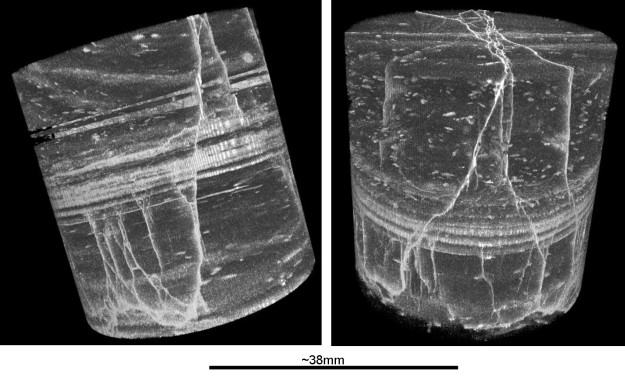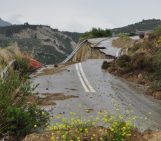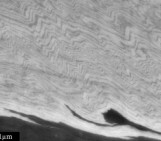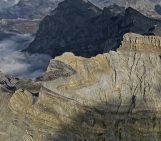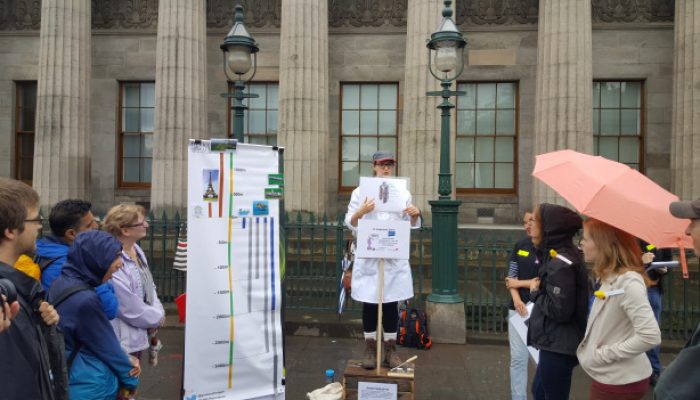
Imagine you find yourself standing atop a wooden box in the middle of your home town, on a rainy weekend day, with the sole aim of talking to passersby about your research work. It can be a rather daunting prospect! How do you decide what the take-home message of your work is: which single nugget of information do you want members of the public to take away after having spoken to you? Even more important still, how are you going to grab their attention in the first place? After all, they’ll be going about their business and not expecting to see you there, on top of your box, least of all talk to you about your work! But if you fancy the challenge, then read on, as Stephanie Zihms, the ECS Representative of the Earth Magnetism and Rock Physics Division, describes her experience doing just that!
Now in its 6th year Soapbox Science is spreading and I was selected to take part in the 1st Edinburgh event on July 24th on The Mound. The weather was typically Scottish but it didn’t seem to bother the crowds and it definitely did not dampen the enthusiasm of the 12 speakers.
I have done a range of different outreach events but I was particularly drawn to Soapbox Science because it specifically promotes female scientists and their work. It was great to meet the other scientists and to see the range of soapbox “performances” as well as the variety of props utilised to showcase each research topic.
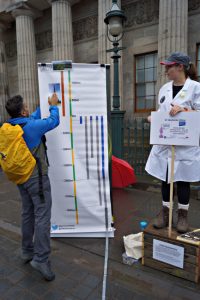
Photo taken at the Soapbox Science event courtesy of Sarah Caldwell (smcneem)
The scary thing for this type of event is that you don’t know who might stop, listen & ask questions since we were standing on The Mound in Edinburgh – this also means that your material has to be accessible and engaging to a wide audience.
Here is what I did to explain my research in geomechanics: Going deeper underground – why do we want to know how rocks behave?
I opted for a big PVC banner showing different heights & depths. With help from the audience I added a picture to each line to show what it represented. I used this banner to set the scene for the type of work I do. I’m a researcher in geomechanics – I want to understand why rocks deform the way they do and what part or component of the rock controls the deformation. The rocks I work with are related to a very deep oil field that lies under 2km of ocean and 5km of rocks. It would take me ~1 hour to run this. At this depth the pressure squeezing the rocks is very high – each square meter of rock experiences the pressure of 16 African elephants per km of depth. So at 5km depths that is 80 African Elephants per square meter.
Under these high pressures the slightest change in conditions e.g. through oil production affects the rocks and changes the distribution of this pressure onto the rocks. I want to understand how different rocks respond to these changes. I do this by collecting rock samples that are easy to get to e.g. from quarries. But they have to be similar to the ones found in the oil field of interest – we call this an analogue (or think of it as a sibling).
In the lab at Heriot-Watt University I have an apparatus that lets me deform rocks under different conditions. The sample, usually a core sample (seeimage above) gets placed into a rubber sleeve before being placed into a stainless steel cell called a Hoek Cell. The space between the rubber sleeve and stainless stell cell is filled with oil that can be pressurised. That way the rock samples can be placed under different pressures that mimic the conditions at different depths. After this initial pressurisation the rock is squeezed in a press until it deforms. When the readings pass a peak value it indicates that the rock sample can’t withstand the squeeze pressure any longer and the test is stopped.
Unfortunatley we can’t see what happens to the rock during the squeezing process but we measure the sample before and after testing – we can also take a x-ray images of the entire sample. We do this with the sample before it is deformed and then again afterwards. This technique lets us see inside the rock – similar to having a x-ray in hospital to see if a bone is broken or not.
Using special computer software we can then look at different parts of the rock’s inside – I am particularly interested in the fractures that formed during the deformation and I’m working on ways to relate these observed features to the rock type, grain size and pore shape.
Why is this important? As I mentioned above I look at rocks related to an oil field – and the response of the rocks to oil production could hinder or help extraction. Oil companies are very interested in predicting the rock response to ensure it does not have a negative impact on oil production.
Additionally this research is also relevant to other areas: for example geothermal energy. One method of generating geothermal energy is by pumping water into a rock that is hotter than the surface to increase the water temperature. When this water then reaches the surface it can be used to generate electricity. Adding water into the rock also changes the pressure conditions. Another field is Carbon Capture & Storage – If we want to store CO2 securely and long-term into the subsurface e.g. in a disused gas field – understanding how rocks respond to changes in conditions firstly by removal of gas & secondly by filling the rocks with CO2 is important.
By Stephanie Zihms, Postdoctoral researcher and ECS Representative of the Earth Magnetism and Rock Physics Division.
This post was published under the original title:Going deeper underground – My Soapbox Science Edinburgh contribution, on Stephanie Zihms’ personal blog.


